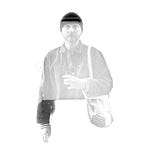A Few Words On Jean Epstein’s The Fall Of The House Of Usher.
Jean Epstein’s best-known film is also one of his most interesting. His 1928 adaptation of Edgar Allan Poe’s short story The Fall Of The House Of Usher displays all of the hallmarks of the French filmmaker’s aesthetic-style, but also carries with it a pretty neat subtextual message that attaches itself tightly to the very essence of a cinema such as Epstein’s; in one of film’s central roles we have a figure whose only person is directly effected by creative pursuit (in this case painting), with said ambitions of creative reproduction quite literally killing the woman, while the walls of the eponymous building crumble in sync with her emotional and physical state. One might look upon this as an analogy for the relationship between the film’s own creator and cinema.
In 1928 a crumbling house couldn’t have been further a symbol of the state of cinema. It was at its peak, about to be disrupted by the coming of sound, with the international cinemas of France and Germany in good spirits following the lull that came with the Great War. Having built his Metropolis the previous year, 1928 saw Fritz Lang complete the film that is arguably his greatest silent achievement, Spione, while Carl Th. Dreyer and his Passion Of Joan Of Arc roared through Europe. In America Murnau’s 4 Devils, now long-lost, followed his masterpiece from 12 months prior, Sunrise, while in France Abel Gance finally let the world see Napoleon, his day-long opus. In the background to all of this stands Epstein, with a decidedly shorter piece than the Gance but one no less affecting. While the two films shared a female lead in Marguerite Gance, wife of Abel (for whom Epstein had a great deal of respect and admiration), this is where the similarities stop. Epstein’s film is an intimate production, one that lives and dies on the strength of its short, sharp punch.
Epstein’s mastery of the form is made clear early on in The Fall Of The House Of Usher. His trademark montage, rooted in the avant-garde and inspired by the Soviets breathes alongside more traditional filmic technique (he leeched from the Germans too). In an early sequence here feelings of domination and seclusion are shown first by the hands of the offending figure before we cut to an angle awe-inspiringly wide for the era, revealing a pair stood far apart, distance everything. Emotion rules. Epstein similarly gives everything over to the frame in that trademark montage, exacerbated by close-ups and liberal use of the focus wheel. A close up of a man riding a horse at speed is so extreme to be illegible out of the context of the cut, while a guitar ballad gives way to the ocean and nature in an attempt to convey a wider, more visual form of cinema than one simply reliant on expeditionary dialogue. It’s perhaps no surprise to learn that master surrealist Luis Bunuel cut his teeth working for Epstein, and indeed played a part in the production of The Fall Of The House Of Usher as the film’s co-writer. While the apprentice would eventually go on to a scale of worldwide success that seems to have somewhat eluded Epstein, that ought not be a reflection of the importance, or indeed the quality of the master’s work.
The film is pretty difficult to find in English-speaking territories, so is attached below. An excellent DVD box-set was collecting a wide range of Epstein’s oeuvre was released in France last year and contains English subtitles.
